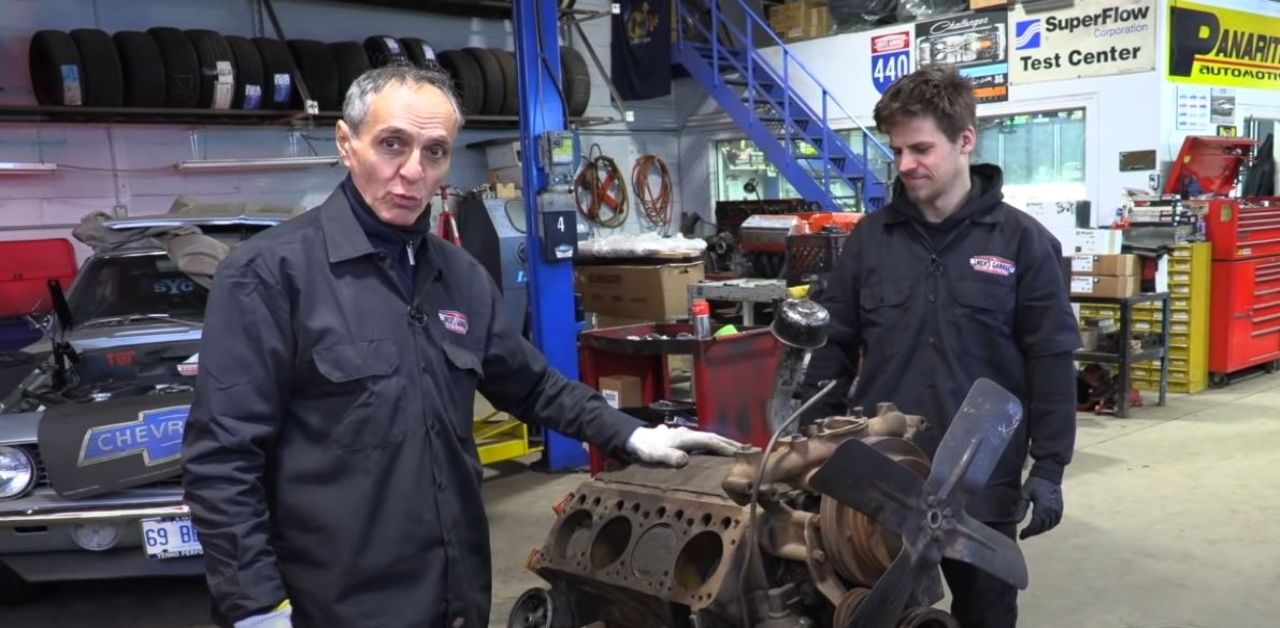Dodge CEO Tim Kuniskis told Motor Authority that the Hellcat engine will exit production after the 2023 model year. They cite “government fines” as the reason. The Hellcat is the pinnacle of the Hemi engine, the third generation of the motor, it boasts impressive power and a historic name. In its current 6.2-liter supercharged form, it produces over 700 horsepower. This performance comes at a price. Fuel economy in the real world barely scrapes double digits, and the emissions are best not to mention. As the industry repositions itself to embrace EVs and their brand of ludicrous performance, the Hemi engines must become a relic of the past. Over three generations, the Hemi lineup has built plenty of relics. One of these is the 354 Hemi from Chrysler, one of the first road-going implementations of the engine design.
This classic engine is as simple as you'd expect.
What Is The 1956 354 V8 Hemi?
According to Nick's Garage, this is the "Grandpa" of Hemi engines. This particular motor left the factory in a 1956 Imperial. An incredibly significant model for Chrysler, from only the second model year when Imperial was a separate brand in the Chrysler lineup. A luxury car but they still needed a powerful engine beneath the hood. The most powerful in this generation of the car was the 354 Hemi V8. At this time the hemispherical cylinder design was engineering's latest method of extracting more power from a motor. With a round design, less fuel comes into contact with the walls of the cylinder. Meaningless energy has the opportunity to escape as heat. This results in much higher cylinder pressure. Chrysler then christened this particular Hemi the Firepower. With 5.8 liters and around 280 horsepower, the motor certainly had the firepower to match the competing Ford Thunderbird.
Chrysler's research and development department quickly developed the Hemi engine into its NASCAR pinnacle. However, in the late 1950s, the 354 sat at the top of the ladder. Featuring not only in the Imperial but the New Yorker, 300B, and Dodge D501. The 354 uses a flat top piston design, meaning that in terms of compression it quickly fell behind the curve in favor of the 426.
How Does The Teardown Go?
The motor came to Nick's garage with the cylinder heads already off, meaning there's a little less work for them. Sat and parked for an unknown amount of time, it won't be the easiest disassembly with seized pistons and over lubricated parts. Making this worse, small amounts of dirt made their way into the unit. The outside of the block has clear signs of rust, and there's surely plenty of corrosion. To avoid breaking bolts, the team will have to use hand tools. However, not everything is the original 1956 parts. The valves look relatively untouched by rust, meaning at some point in the past 60 years someone took this apart. It's worth noting that this is where the issue is with the Hemi design, each cylinder can only have two valves, which limits how much fuel can get through the cylinder.
Removing the fan doesn't present much of a challenge but the water pump does. Mounted behind the pump, it confuses Nick's younger mechanic. Since the 354's production run, engine design has moved on massively. When stripping older engines this is where most problems arise.
Throughout this process, they keep all the parts they intend to replace. Nick explains the logic here. They're not simply taking apart the engine but also going to be putting it back together. This means that it has to run and to do that requires every gasket and lifter in the cam. Holding on to these parts means they can account for everything they take off and put back on the motor. Assembling an older engine like this is just like building flat-pack furniture, and there's nothing worse than having a spare screw.
What's The Bare Block Like?
The final part to come out is the camshaft. Nick comments that all the lobes are these. He suggests they could polish it and throw it back in. Continuing to make the recommendation that you hold on to the original camshaft. Easily modifiable to build up or take down they can fit a range of older engines that parts aren't in production for anymore. Although newer parts will take their place. As the 354 teardown progresses, they search for serial numbers before drawing a blank. This means that the parts on this motor are standard and should still be on sale, even 66 years later.
With the cam out it's clear that although the engine block itself might have some external rust and wear, the inside is still perfectly serviceable. If this engine found its way into a show car, removing this rust would be pretty simple. However, it shouldn't impact the running of the Hemi engine. With the engine block staying and almost none of the other parts, Nick accidentally steps into an interesting philosophical debate. Replacing everything but the block, surely this is a new engine. It's still a 354, no modification to the bore, and stroke will happen. This 1956 Firepower 354 will surely have a second life as a 2022 Firepower 354.


.jpg)
.jpg)